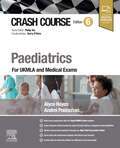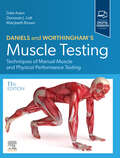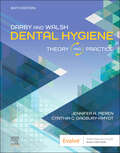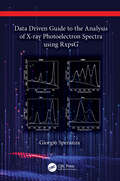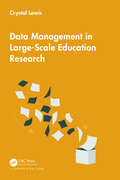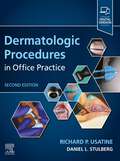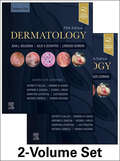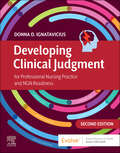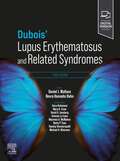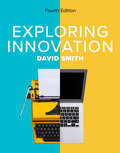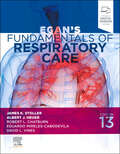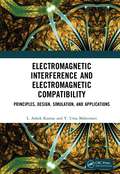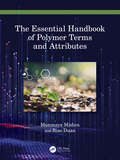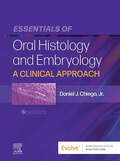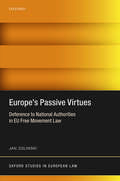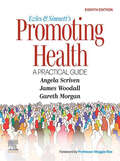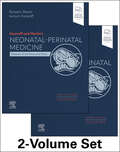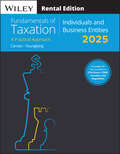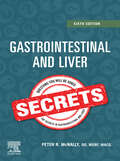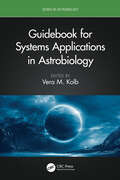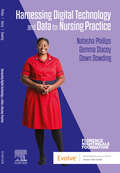- Table View
- List View
Crash Course Paediatrics: For UKMLA and Medical Exams (CRASH COURSE)
by Alyce Hayes Andrei PobischanCrash Course – your effective every-day study companion PLUS the perfect antidote for exam stress! Save time and be assured you have the essential information you need in one place to excel on your course and achieve exam success. A winning formula now for over 25 years, having sold over 1 million copies and translated in over 8 languages, each series volume has been fine-tuned and fully updated with a full-colour layout tailored to make your life easier. Especially written by senior students or junior doctors – those who understand what is essential for exam success – with all information thoroughly checked and quality assured by expert Faculty Advisers, the result is books that exactly meet your needs and you know you can trust. Each chapter guides you succinctly through the full range of curriculum topics in the UKMLA syllabus, integrating clinical considerations with the relevant basic science and avoiding unnecessary or confusing detail. A range of text boxes help you get to the hints, tips and key points you need fast! A fully revised self-assessment section matching the latest exam formats is included to check your understanding and aid exam preparation. The accompanying enhanced, downloadable eBook completes this invaluable learning package. Series volumes have been honed to meet the requirements of today’s medical students, although the range of other health students and professionals who need rapid access to the essentials of paediatrics will also love the unique approach of Crash Course. Whether you need to get out of a fix or aim for a distinction Crash Course is for you! Crash Course Paediatrics combines current information with self-assessment and high-yield association tables that will empower students with knowledge to succeed in exams. In this new edition, readers will find new content on anatomy in children, COVID-19, and PIMMS.Fully aligned to UKMLA requirements, with key ‘conditions’ and ‘presentations’ highlighted in handy checklists - save valuable revision time and be confident you have the syllabus coveredWritten by senior students and recent graduates - those closest to what is essential for exam successQuality assured by leading Faculty Advisors - ensures complete accuracy of informationFeatures the ever popular 'Hints and Tips' boxes and other useful aide-mémoires - distilled wisdom from those in the knowUpdated self-assessment section matching the latest exam formats – confirm your understanding and improve exam technique fast
Cultures of Modernity and the U.S.-Japan Cold War Alliance (Routledge Studies In The Modern History Of Asia Ser.)
by Masami KimuraCultures of Modernity and the U.S.-Japan Cold War Alliance reconsiders the origins of postwar U.S.-Japan relations by focusing on “modernization” ideologies that the Americans and the Japanese shared in the 1940s–early 1950s. Mobilizing a wealth of English and Japanese-language sources, the author identifies parallel groups of modernist thinkers in America and Japan – including politicians, bureaucrats, intellectuals, scholars, and journalists – and follows how different strands of thought played out within an evolving political environment, forming a “middle ground.” Despite their differences, both the Americans and the Japanese believed in the progressive view of history, considered Japan to be still underdeveloped, and therefore agreed on the advisability of democratizing Japan – which included constitutional reform. Whether proponents or opponents of the U.S.-Japan Cold War alliance system, they also shared the vision of Wilsonian internationalism and devised similar designs for a postwar Asian order where Japan would rejoin. Thus, by showing how the confluence of modernist cultures helped forge a postwar relationship between the two, this study contributes to the field of postwar U.S.-Japan relations by supplementing and reorienting the scope of scholarship, one that has been predominantly America-centered and framed along the line of diplomatic narratives informed by Cold War politics.
Daniels and Worthingham's Muscle Testing - E-Book: Daniels and Worthingham's Muscle Testing - E-Book
by Dale Avers Donovan J. Lott Marybeth BrownDaniels and Worthingham's Muscle Testing, 11th Edition offers the clear information needed to master procedures and enhance clinical decision making in manual muscle testing and performance testing. Comprehensive discussion of the value of strength testing with clear, illustrated instructions provide a detailed guide to patient positioning, clinician instructions, and application of skill. In addition to updated muscle testing of normal individuals and others with weakness or paralysis, this edition includes updated information on alternative strength and performance tests for all adult populations. Updated comprehensive coverage for muscle dynamometry and ideal exercises enhances this texts’ relevance for today’s clinician. An eBook version included with print purchase provides access to all the text, figures, and references, with the ability to search, customize content, make notes and highlights, and have content read aloud. Drawings and arrows, along with clear written directions, make it easy to understand and perform muscle testing procedures to assess deficits in strength, balance, and range of motion. More than 500 illustrations clearly show testing sequences, muscle anatomy, and muscle innervation. Content on the muscle dynamometer and muscle dynamometry data introduces you to muscle dynamometry, including muscle dynamometer methods and results with each muscle. Ideal exercises for selected muscles thoroughly explain procedures based on the literature. Chapter on functional performance testing covers functional strength testing in older adults and those with functional decline, and testing muscle performance in various clinical settings. Chapter on strength testing for active populations includes a variety of tests appropriate for many settings with reference data for comparison. Chapters on manual muscle testing address how to enhance the reliability and validity of manual muscle testing and other practical considerations of manual muscle testing. Details of muscle anatomy and innervation help in linking muscle topography with function. Clinical Relevance and Substitutions boxes provide additional tips and highlight muscle substitutions that may occur during a test to ensure greater accuracy. A constant reference number clearly identifies each muscle in the body, indexed in the Alphabetical List of Muscles by Region as well as in the Ready Reference Anatomy chapter in the eBook included with print purchase, to speed cross-referencing and help you quickly identify any muscle. Updated content throughout provides the most current information needed to be an effective practitioner. Updated references ensure content is current and applicable for today’s practice. NEW! eBook version included with print purchase provides access to all the text, figures, and references, with the ability to search, customize content, make notes and highlights, and have content read aloud. Plus, the eBook includes video clips and bonus Ready Reference Anatomy and Assessment of Muscles Innervated by Cranial Nerves content.
Darby & Walsh Dental Hygiene - E-Book: Darby & Walsh Dental Hygiene - E-Book
by Jennifer A. Pieren Cynthia C. Gadbury-AmyotDarby & Walsh Dental Hygiene: Theory and Practice, 6th Edition offers everything you need to succeed in your coursework and clinical and professional practice. No other dental hygiene foundational text incorporates clinical competencies, theory, and evidence-based practice in such an approachable way. All discussions — from foundational concepts to diagnosis to pain management — are presented within the context of a unique person-centered model that takes the entire person into consideration. A veritable who’s-who of dental hygiene educators, practitioners, and researchers cite the latest studies throughout the text to provide a framework to help you in your decision-making and problem-solving. New to this edition is an increased focus on new and emerging technologies, enhanced coverage of infection control in the time of COVID-19, and new chapters on telehealth and teledentistry and mental health and self-care.· Focus on research and evidence-based practice, with expert chapter authors (educators, practitioners, and researchers) from across the United States and beyond· Step-by-step procedure boxes with accompanying illustrations, clinical photos, and rationales; procedure videos online included with new text purchase· Expansive art program, featuring modern illustrations and updated clinical photos· Human Needs Conceptual Model Framework in which all discussions are presented within the context of a client-centered model that takes the entire person into consideration· Chapter features including professional development opportunities; learning competencies; patient education tips; critical thinking scenarios; and discussions of legal, ethical, and safety issues to hone practical application and problem solving, and to bring the profession to life for students NEW! Increased focus on new and emerging technologies keeps you up to date with the latest advances in the field. NEW! Telehealth chapter explains how to practice telehealth and teledentistry in nontraditional and community-based settings. NEW! Mental Health and Self-Care chapter provides timely content on safeguarding mental health and wellness for the practitioner and the patient. UPDATED! Enhanced coverage of infection control prepares you to practice as a dental hygienist in the time of COVID-19 and potential future pandemic events. UPDATED! Coverage of Caries Management by Risk Assessment (CAMBRA®) for integrating into the dental hygiene process of care. EXPANDED! Further integration of the current American Academy of Periodontology periodontal classifications throughout the text. Integration of theory throughout the book includes content on how to incorporate the use of theory in practice.
Data Driven Guide to the Analysis of X-ray Photoelectron Spectra using RxpsG
by Giorgio SperanzaThis book provides a theoretical background to X-ray photoelectron spectroscopy (XPS) and a practical guide to the analysis of the XPS spectra using the RxpsG software, a powerful tool for XPS analysis. Although there are several publications and books illustrating the theory behind XPS and the origin of the spectral feature, this book provides an additional practical introduction to the use of RxpsG. It illustrates how to use the RxpsG software to perform specific key operations, with figures and examples which readers can reproduce themselves. The book contains a list of theoretical sections explaining the appearance of the various spectral features (core‑lines, Auger components, valence bands, loss features, etc.). They are accompanied by practical steps, so readers can learn how to analyze specific spectral features using the various functions of the RxpsG software. This book is a useful guide for researchers in physics, chemistry, and material science who are looking to begin using XPS, in addition to experienced researchers who want to learn how to use RxpsG. In the digital format, the spectral data and step-by-step indications are provided to reproduce the examples given in the textbook. RxpsG is a free software for the spectral analysis. Readers can find the installation information and download the package from https://github.com/GSperanza/ website. RxpsG was developed mainly by Giorgio Speranza with the help of his colleague dr. Roberto Canteri working at Fondazione Bruno Kessler. Key Features: Simplifies the use of RxpsG, how it works, and its applications. Demonstrates RxpsG using a reproduction of the graphical interface of RxpsG, showing the steps needed to perform a specific task and the effect on the XPS spectra. Accessible to readers without any prior experience using the RxpsG software. Giorgio Speranza is Senior Researcher at Fondazione Bruno Kessler – Trento Italy, Associate Member of the Italian National Council of Research, and Associate Member of the Department of Industrial Engineering at the University of Trento, Italy.
Data Driven Guide to the Analysis of X-ray Photoelectron Spectra using RxpsG
by Giorgio SperanzaThis book provides a theoretical background to X-ray photoelectron spectroscopy (XPS) and a practical guide to the analysis of the XPS spectra using the RxpsG software, a powerful tool for XPS analysis. Although there are several publications and books illustrating the theory behind XPS and the origin of the spectral feature, this book provides an additional practical introduction to the use of RxpsG. It illustrates how to use the RxpsG software to perform specific key operations, with figures and examples which readers can reproduce themselves. The book contains a list of theoretical sections explaining the appearance of the various spectral features (core‑lines, Auger components, valence bands, loss features, etc.). They are accompanied by practical steps, so readers can learn how to analyze specific spectral features using the various functions of the RxpsG software. This book is a useful guide for researchers in physics, chemistry, and material science who are looking to begin using XPS, in addition to experienced researchers who want to learn how to use RxpsG. In the digital format, the spectral data and step-by-step indications are provided to reproduce the examples given in the textbook. RxpsG is a free software for the spectral analysis. Readers can find the installation information and download the package from https://github.com/GSperanza/ website. RxpsG was developed mainly by Giorgio Speranza with the help of his colleague dr. Roberto Canteri working at Fondazione Bruno Kessler. Key Features: Simplifies the use of RxpsG, how it works, and its applications. Demonstrates RxpsG using a reproduction of the graphical interface of RxpsG, showing the steps needed to perform a specific task and the effect on the XPS spectra. Accessible to readers without any prior experience using the RxpsG software. Giorgio Speranza is Senior Researcher at Fondazione Bruno Kessler – Trento Italy, Associate Member of the Italian National Council of Research, and Associate Member of the Department of Industrial Engineering at the University of Trento, Italy.
Data Management in Large-Scale Education Research
by Crystal LewisResearch data management is becoming more complicated. Researchers are collecting more data, using more complex technologies, all the while increasing the visibility of our work with the push for data sharing and open science practices. Ad hoc data management practices may have worked for us in the past, but now others need to understand our processes as well, requiring researchers to be more thoughtful in planning their data management routines. This book is for anyone involved in a research study involving original data collection. While the book focuses on quantitative data, typically collected from human participants, many of the practices covered can apply to other types of data as well. The book contains foundational context, instructions, and practical examples to help researchers in the field of education begin to understand how to create data management workflows for large-scale, typically federally funded, research studies. The book starts by describing the research life cycle and how data management fits within this larger picture. The remaining chapters are then organized by each phase of the life cycle, with examples of best practices provided for each phase. Finally, considerations on whether the reader should implement, and how to integrate those practices into a workflow, are discussed. Key Features:
Dermatologic Procedures in Office Practice
by Richard P. Usatine Daniel L. StulbergNow in a convenient and easy-to-use softcover format, Dermatologic Procedures in Office Practice, 2nd Edition, offers clear, step-by-step guidance on the many dermatologic procedures successfully performed in the office setting. This highly visual reference provides full-color photographs and drawings in combination with high-definition, narrated videos to demonstrate key procedures, including the diagnosis and treatment of benign and malignant lesions; cryosurgery; electrosurgery; dermoscopy; excision of skin cancers, cysts, lipomas; and more. The eBook and online videos are the perfect companion when adding a new procedure to your practice.Covers in-office dermatologic procedures focused on today’s primary care practice.Uses a concise, step-by-step, bulleted format, including set-up, complication avoidance, pearls and pitfalls, and recovery for each procedure.Features an exclusive online library of more than 100 videos, as well as procedural images and patient photographs, photographs of devices and instruments, diagrams, and medical illustrations throughout the text from expert clinicians.Contains new chapters on Biopsies and Excisions in Challenging Locations (face, ears, nose, genital areas) and Dermoscopy of Other Lesions in General Dermatology.Includes handy appendices with sample consent forms, patient education handouts, and a table recommending when to use various procedures based on the diagnosis. Any additional digital ancillary content may publish up to 6 weeks following the publication date.
Dermatology - E-Book: 2-Volume Set
by Jean L. Bolognia Julie V. Schaffer Lorenzo CerroniFor dermatology residents and trainees, as well as those in clinical practice, Dermatology is the leading reference for understanding, diagnosing, and treating the full spectrum of skin disease—and is the key resource that residents rely on throughout their training and certification. Widely recognized for its easy-in, easy-out approach, this revised 5th Edition turns complex information into user-friendly visual content through the use of clear, templated chapters, digestible artwork, and easy-to-follow algorithms and tables. This two-volume masterwork provides complete, authoritative coverage of basic science, clinical practice of both adult and pediatric dermatology, dermatopathology, and dermatologic surgery—more than any other source, making it the gold standard reference in the field today.Simplifies complex content in a highly accessible, highly visual manner, with 1,100+ tables; 2,600+ figures, including numerous disease classification algorithms as well as diagnostic and therapeutic pathways; and over 1,500 additional figures and tables online.Utilizes weighted differential diagnosis tables and a "ladder" approach to therapeutic interventions.Any additional digital ancillary content may publish up to 6 weeks following the publication date.Features an intuitive organization and color-coded sections that allow for easy and rapid access to the information you need.Retains an emphasis on clinicopathologic correlations, with photomicrographs demonstrating key histologic findings adjacent to clinical images of the same disorder.Contains updated treatment information throughout, including immune checkpoint inhibitors, JAK inhibitors, and monoclonal antibodies for a wide range of conditions such as psoriasis, atopic dermatitis, alopecia areata, vitiligo, and skin cancers.Provides up-to-date information on genetic and molecular markers and next-generation sequencing as it applies to dermatologists.Features new videos, including cryosurgical and suturing techniques, treatment of rhinophyma via electrosection, and neuromodulator treatment of axillary hyperhidrosis.Includes new WHO classifications of skin tumors, new FDA pregnancy drug labeling, and new ACR/EULAR criteria for vasculitis and lupus erythematosus.Includes new sections on confocal microscopy and artificial intelligence.
Developing Clinical Judgment for Professional Nursing Practice and NGN Readiness - E-Book: Developing Clinical Judgment for Professional Nursing Practice and NGN Readiness - E-Book
by Donna D. IgnataviciusDevelop the clinical judgment skills needed to pass the Next-Generation NCLEX-RN® Exam (NGN) on your first try with this one-of-a-kind workbook! Developing Clinical Judgment for Professional Nursing Practice and NGN Readiness, 2nd Edition provides practical thinking exercises and case studies to help you build clinical judgment skills and make safe clinical decisions. The workbook offers practice with all NGN item types, including the new "bowtie" items. And all core nursing content areas are covered, with chapters organized to guide you through the entire NGN test plan. From renowned nursing educators Donna D. Ignatavicius and Tamil Little, this practical resource ensures that you’re ready for all of the item types you will encounter on the NGN and ready to apply clinical judgment skills in RN practice. Emphasis on clinical judgment skills helps you prepare for the Next-Generation NCLEX-RN® Examination (NGN) through practical thinking exercises in which you apply the cognitive skills delineated in the National Council of State Boards of Nursing (NCSBN) Clinical Judgment Measurement Model (CJMM) to realistic case studies. Comprehensive collection of clinical reasoning exercises allows you to answer questions ranging from basic to more complex, each based on a challenging client situation. Evolve website offers the opportunity to answer questions in an interactive format for a realistic test-taking experience with automated scoring and remediation. Answer key at the end of the book includes detailed rationales and references for each question. Questions organized into six parts address all core clinical areas, guiding you through the entire NGN test plan. NEW! Completely new organization by core content areas divides the book into these parts: medical-surgical, psychiatric-mental health, pediatric, maternal-newborn, and critical care. NEW! Four new chapters and expanded content throughout address all 14 item types for the Next-Generation NCLEX® Exam (NGN) with unfolding case studies and standalone thinking exercises. NEW! Fully updated content also reflects the latest NCLEX-RN® test plan, the most current evidence-based practice, and the latest national and international guidelines. NEW! Item types for the NGN include the new "bowtie" items, preparing you for the types of questions encountered on the NGN. NEW! All-new practice questions provide more robust preparation for the NGN. NEW! Integration of pharmacology exercises is provided in all core chapters, and all pharmacology questions are highlighted with a distinctive icon. NEW! Medical record illustrations show client information for thinking exercises in case studies.
Dubois' Lupus Erythematosus and Related Syndromes - E-Book: Expert Consult - Online
by Daniel J. Wallace Bevra Hannahs Hahn Anca Askanase Mary K. Crow David A. Isenberg Antonio La Cava Maureen A. McMahon Betty P. Tsao Swamy Venuturupalli Michael H. WeismanFor more than 50 years, Dubois’ Lupus Erythematosus and Related Syndromes has been recognized internationally as the go-to clinical reference on lupus and other connective tissue diseases. From basic scientific principles to practical points of clinical management, the 10th edition provides extensive, authoritative coverage of systemic lupus erythematosus (SLE) and its related diseases in a logical, clearly written, user-friendly manner. It’s an ideal resource for rheumatologists and internal medicine practitioners who need a comprehensive clinical reference on all aspects of SLE, connective tissue diseases, and the antiphospholipid syndromes.Provides complete clinical coverage of every aspect of cutaneous and systemic lupus erythematosus, including definitions, pathogenesis, autoantibodies, clinical and laboratory features, management, prognosis, and patient education.Includes significant new content throughout: a new chapter on the endocrine system and hormones; newly distinct chapters on the heart and lung; new content on social disparities in lupus, clinical presentation of nephritis, and pulmonary hypertension; a new concluding chapter on future directions in the field; new basic science coverage of the microbiome, autoinflammatory, and monogenic lupus; and new coverage of diversity, inclusion, gender, compliance, and adherence.Offers a fresh perspective from two new associate editors and many new authors with representation from 30 countries.Contains an up-to-date overview of significant advances in cellular, molecular, and genetic technologies, including genetic advancements in identifying at-risk patients.Discusses the clinical management of related disorders such as Sjogren’s syndrome, scleroderma, polymyositis, and antiphospholipid syndrome (APS).Presents the knowledge and expertise of international contributors to provide new global perspectives on manifestations, diagnosis, and treatment.Features a vibrant, full-color format, with graphs, algorithms, differential diagnosis comparisons, new and improved figures, and schematic diagrams throughout.Additional digital ancillary content may publish up to 6 weeks following the publication date.
Egan's Fundamentals of Respiratory Care: Egan's Fundamentals of Respiratory Care - E-Book
by James K. Stoller Albert J. Heuer Robert L. Chatburn Eduardo Mireles-Cabodevila David L. VinesMaster the principles and skills you’ll need to succeed as a respiratory therapist! Egan’s Fundamentals of Respiratory Care, 13th Edition provides a solid foundation in respiratory care and covers the latest advances in this dynamic field. For more than 50 years, this text has been the go-to resource to understand the role of the respiratory therapist, the scientific basis for treatment, and clinical applications. Comprehensive chapters prepare you for clinical and exam success by correlating to the 2020 NBRC Exam matrices. The 13th Edition includes updated coverage of COVID-19, the latest AARC clinical practice guidelines, and a new enhanced eBook version included with print purchase.
Electromagnetic Interference and Electromagnetic Compatibility: Principles, Design, Simulation, and Applications
by L. Ashok Kumar Y. Uma MaheswariElectromagnetic compatibility is concerned with the generation, transmission, and reception of electromagnetic energy. The book discusses about the basic principles of electromagnetic interference (EMI) and electromagnetic compatibility (EMC) including causes, events, and mitigation of issues. The design procedures for EMI filter, the types of filters, and filter implementation methods are explained. The simulation of printed circuit board designs using different software and a step-by-step method is discussed in detail. This book addresses the gap between theory and practice using case studies with design, experiments, and supporting analysis. Features:• Discusses about the basic principles of EMI/EMC including causes and events.• Makes readers understand the problems in different applications because of EMI/EMC and the reducing methods.• Explores real-world case studies with code to provide hands-on experience.• Reviews design strategies for mitigation of noise.• Includes MATLAB, PSPICE, and ADS simulations for designing EMI Filter circuits. The book is aimed at graduate students and researchers in electromagnetics, circuit and systems, and electrical engineering.
Electromagnetic Interference and Electromagnetic Compatibility: Principles, Design, Simulation, and Applications
by L. Ashok Kumar Y. Uma MaheswariElectromagnetic compatibility is concerned with the generation, transmission, and reception of electromagnetic energy. The book discusses about the basic principles of electromagnetic interference (EMI) and electromagnetic compatibility (EMC) including causes, events, and mitigation of issues. The design procedures for EMI filter, the types of filters, and filter implementation methods are explained. The simulation of printed circuit board designs using different software and a step-by-step method is discussed in detail. This book addresses the gap between theory and practice using case studies with design, experiments, and supporting analysis. Features:• Discusses about the basic principles of EMI/EMC including causes and events.• Makes readers understand the problems in different applications because of EMI/EMC and the reducing methods.• Explores real-world case studies with code to provide hands-on experience.• Reviews design strategies for mitigation of noise.• Includes MATLAB, PSPICE, and ADS simulations for designing EMI Filter circuits. The book is aimed at graduate students and researchers in electromagnetics, circuit and systems, and electrical engineering.
The Essential Handbook of Polymer Terms and Attributes
by Munmaya Mishra Biao DuanThe Essential Handbook of Polymer Terms and Attributes not only acts as an encyclopedia of polymer science but also fosters an appreciation for the significance of polymers in fields including materials science, chemistry, engineering, and medicine. This book serves as an excellent reference book, covering every possible term and attribution associated with the vast and diverse field of polymers. This comprehensive volume serves as a vital resource for researchers working in industry and academia, offering a clear and concise exploration of polymer science with the most essential reference data available. Each polymer term is defined in a straightforward manner, ensuring that readers of all levels can grasp the concepts. The book goes beyond mere definitions, providing context and insights into the applications, properties, and synthesis. Bringing polymer terms and attributes together in one place, the book provides a broad knowledge of polymer science and facilitates idea generation for researchers and students embarking on projects related to a specific field of polymer science. Key features: • This book covers all possible terms associated with the field of “polymers” and related areas, granting readers a comprehensive understanding of the entire spectrum of polymers. • The organization of the book follows an alphabetical format, enabling quick and convenient access to specific terms. • Each polymer term is clearly defined with a figure or scheme as needed, allowing readers to visualize the structures, processes, and applications involved. This book is written for science students, chemists, polymer scientists, chemical engineers, pharmaceutical scientists, biomedical scientists, biotechnologists, product formulators, materials scientists, and scientists working on polymers.
Essentials of Oral Histology and Embryology E-Book: Essentials of Oral Histology and Embryology E-Book
by Daniel J. Chiego Jr.Essentials of Oral Histology and Embryology: A Clinical Approach, 6th Edition uses a patient-centered approach to help dental professionals build a strong foundation in oral biology and basic science. It provides clear explanations of the anatomy of oral and facial tissues — and of normal and abnormal orofacial development — so that you can provide effective oral health care for all patients. In addition to the stages of tooth development, it covers eruption and shedding of teeth, plus the parts of teeth — including enamel, dentin, dental pulp, and cementum. Written by Daniel J. Chiego, Jr., a noted dental educator and researcher, this book gives you the knowledge you need to succeed in the classroom and in clinical practice. Cutting-edge content provides essential knowledge of the basics of oral biology with a focus on practical clinical application. Clinical Comment, Consider the Patient, Quandaries in Science, and Case Study boxes apply scientific content to everyday dental practice and explore the boundaries of scientific research. Self-evaluation questions and practice quizzes help you prepare for classroom and national board exams. NEW! Coverage of COVID-19 includes how the virus affects the oral cavity. Updated full-color illustrations, micrographs, and histographs add to the already robust art program that supplements content by depicting various stages within the development of oral structures.
Europe's Passive Virtues: Deference to National Authorities in EU Free Movement Law (Oxford Studies in European Law)
by Jan ZglinskiThe European Court of Justice has been celebrated as a central force in the creation and deepening of the EU internal market. Yet, it has also been criticized for engaging in judicial activism, restricting national regulatory autonomy, and taking away the powers of Member State institutions. In recent years, the Court appears to afford greater deference to domestic actors in free movement cases. Europe's Passive Virtues explores the scope of and reasons for this phenomenon. It enquires into the decision-making latitude given to the Member States through two doctrines: the margin of appreciation and decentralized judicial review. At the heart of the book lies an original empirical study of the European Court's free movement jurisprudence from 1974 to 2013. The analysis examines how frequently and under which circumstances the Court defers to national authorities. The results suggest that free movement law has substantially changed over the past four decades. The Court is leaving a growing range of decisions in the hands of national law-makers and judges, a trend that affects the level of scrutiny applied to Member State action, the division of powers between the European and national judiciary, and ultimately the nature of the internal market. The book argues that these new-found 'passive virtues' are linked to a series of broader political, constitutional, and institutional developments that have taken place in the EU.
Ewles and Simnett’s Promoting Health: Ewles and Simnett’s Promoting Health: A Practical Guide - E-Book
by Angela Scriven Gareth Morgan James WoodallThe eighth edition of this seminal guide is designed to support public health practitioners in keeping up-to-date amid the rapidly changing, complex challenges and contexts facing population health in the twenty-first century. Suitable for both undergraduates and postgraduates across a range of professions, the Practical Guide provides theories, principles and competencies for effective health promotion in multiple settings. The book is organised into three parts, covering an overview of the public health landscape, the essentials of planning and management, and how to develop capabilities across a range of activities. The text has been fully updated to examine new issues facing public health, including restructuring of the UK sector post-European Union; COVID-19 and its public health impact and legacy; economic and cost of living influences on population health; and the role of the internet and social media misinformation.Includes promotion of healthier living, working with communities and effective communicationOutlines new research on the comparative effectiveness of different approaches to health promotion and public health practiceExplores the increasing influence of the internet, both in terms of its use for health promotion and its negative influence on wellbeing and healthDescribes changes to the structure and organisation of public health in the UK, including the latest policies and national strategies Accessible writing style – makes it easy to learn and rememberCase studies bring theory to lifePractice points help readers structure studyLatest evidence on the response to the COVID-19 pandemic – a permeating theme throughout the bookAll policy sections updated to reflect current policy frameworks and agendasNew health data plus recent research on the comparative effectiveness of different approaches to health promotion and public health practiceAll case studies replaced with current scenarios; more global examples of public health and health promotion actionFully updated references and practice examples
Fanaroff and Martin's Neonatal-Perinatal Medicine: Diseases of the Fetus and Infant
by Richard J. Martin Avroy A. FanaroffA must-have reference for both general physicians and advanced practice providers, Fanaroff and Martin's Neonatal-Perinatal Medicine: Diseases of the Fetus and Infant provides trusted, time-tested guidance on the management and evidence-based treatment of problems in the mother, fetus, and neonate. The fully revised 12th Edition is an ideal resource for every stage of practice and remains the most comprehensive, multidisciplinary text in the field. Drs. Richard J. Martin and Avroy A. Fanaroff from Rainbow Babies and Children’s Hospital bring you up to date with everything from diagnosis and treatment selection through post-treatment strategies and management of complications—all with a dual focus on neonatology and perinatology, and all designed to help you improve the quality of life and long-term outcomes of your patients.Provides up-to-date, evidence-based content throughout, including state-of-the-art coverage of personalized medicine and genetics.Contains new chapters on Big Data for the Smallest Patients: What we can learn from neonatal database research; Role of Umbilical Cord Management in Neonatal Resuscitation; Care of Periviable Micropremies: the Japanese perspective; Longer Term Respiratory Outcomes of Prematurity; and Perinatal Palliative Care.Features extensive updates throughout, including blood and the hematopoietic system; social and economic contributors to neonatal outcome; fetal growth restriction; diagnostic imaging of the neonate; anesthesia in the neonate; postnatal bacterial infections; neonatal management of congenital heart disease; and retinopathy of prematurity.Includes over 600 detailed, full-color illustrations that depict disorders in the clinical setting and explain complex information.Provides indexing in both volumes that provides quick access to specific guidance.Offers a global perspective with an expanded number of international contributors.An ideal resource for clinical practice as well as recommended reading for neonatology board review or maintenance of certification.Any additional digital ancillary content may publish up to 6 weeks following the publication date.
Fundamentals of Taxation for Individuals and Business Entities: A Practical Approach
by null Gregory A. Carnes null Suzanne YoungbergFUNDAMENTALS OF TAXATION An innovative approach to understanding the federal income tax laws and using them to develop tax-efficient strategies for individuals and businesses. Present the big picture with a practice-based approach to understanding tax laws so students can develop critical thinking and problem-solving skills that prepare them for the real world. Fundamentals of Taxation — Individuals and Business Entities, 2025 Edition introduces a logical foundation for the income tax system so students can understand why a law exists and how to apply the law to practical tax problems. Professional skill-building exercises develop critical thinking and communication skills and the ability to identify and address ethical dilemmas, preparing students to be effective tax professionals. AN INTERACTIVE, MULTIMEDIA LEARNING EXPERIENCE This textbook includes access to an interactive, multimedia e-text. Videos and Animations Fundamentals of Taxation for Individuals — Business Entities, 2025 Edition integrates abundant video content developed to complement the text and engage readers more deeply. Content Review Videos provide a detailed review of each learning objective in each chapter and help students learn key concepts and an understanding of tax laws, the big picture, and the Why behind it. Provide confidence-building opportunities with a wide range of practice problems and author-created Solution Walkthrough Videos that give step-by-step instruction on how to complete problems like those in the text. References in the text show when an end-of-chapter problem should be worked so students can immediately apply what they just learned. Task-Based Simulation Problems include realistic source documents such as 1099s, W-2s, invoices, and legal agreements that students use to solve problems. Self-Tests and Practice Questions The e-text also includes self-scoring concept check quizzes. Downloadable Figures These appear throughout the e-text, enabling students to see and work with tax forms and legal agreements.
Gastrointestinal and Liver Secrets: Gastrointestinal and Liver Secrets E-Book (Secrets)
by Peter R. McNallyFor more than 30 years, the highly regarded Secrets Series® has provided students and practitioners in all areas of health care with concise, focused, and engaging resources for quick reference and exam review. Gastrointestinal and Liver Secrets, 6th Edition (formerly known as GI/Liver Secrets), offers practical, up-to-date coverage of the full range of essential topics in this dynamic field. This highly regarded resource features the Secrets’ popular question-and-answer format that also includes lists, tables, pearls, memory aids, and an easy-to-read style – making inquiry, reference, and review quick, easy, and enjoyable. The proven Secrets Series® format gives you the most return for your time – succinct, easy to read, engaging, and highly effective. Fully revised and updated throughout, making it an excellent resource for understanding the physiology and therapy of hepatic and digestive disease. New chapters on Microbiome and Surgery for Inflammatory Bowel Disease. Top 100 Secrets provide a fast overview of the secrets you must know for success in practice and on exams. More than 250 full-color illustrations, endoscopic images, micrographs, and algorithms, plus videos and clinical vignettes online. Bulleted lists, mnemonics, practical tips from global leaders in the field – all providing a concise overview of important board-relevant content. Portable size makes it easy to carry with you for quick reference or review anywhere, anytime.
Guidebook for Systems Applications in Astrobiology (Series in Astrobiology)
This book addresses the timely subject of systems applications in astrobiology. It demonstrates how astrobiology – a multidisciplinary, interdisciplinary, and transdisciplinary field of science – can benefit from adopting the systems approach. Astrobiology draws upon its founding sciences, such as astronomy, physics, chemistry, biochemistry, geology, and planetary sciences. However, astrobiologists can encounter difficulties working across these fields. The systems approach, we believe, is the best contemporary approach to consider astrobiology holistically. The approach is currently used in other fields, such as engineering, which uses systems analysis routinely. Such an approach needs to be learned, both in principle and through examples, from the field. This book features chapters from experts across the field of astrobiology who have applied the systems approach. It will be a valuable guide for astrobiology students at the advanced undergraduate and graduate levels, in addition to researchers in the field, both in academia and the space industry. Key Features: Offers a unique and novel approach to studying and understanding astrobiology Encourages astrobiologists to apply a holistic systems approach to their work, rather than being bogged down in details Imparts practical knowledge to readers which can be adopted in different research and job opportunities in the field of astrobiology Vera M. Kolb obtained degrees in chemical engineering and organic chemistry from Belgrade University, Serbia, and earned her PhD in organic chemistry from Southern Illinois University, Carbondale, Illinois, United States. Following a 30-year career, she is Professor Emerita of Chemistry at the University of Wisconsin-Parkside, Kenosha, Wisconsin. During her first sabbatical leave with the NASA Specialized Center of Research and Training (NSCORT) in Astrobiology, she conducted research with Dr. Leslie Orgel at the Salk Institute and Prof. Stanley Miller at UC San Diego. Her second sabbatical was with Prof. Joseph Lambert at Northwestern University, where she studied sugar silicates and their potential astrobiological relevance. She is credited for authoring over 160 publications, in the fields of organic and medicinal chemistry, green chemistry, and astrobiology, including several books. Recently, she authored Green Organic Chemistry and Its Interdisciplinary Applications (CRC 2016). In the astrobiology field, she edited Astrobiology: An Evolutionary Approach (CRC 2015) and Handbook of Astrobiology (CRC 2019). She co-authored (with Benton C. Clark) Astrobiology for a General Reader: A Questions and Answers Approach (CSP 2020) and Systems Approach to Astrobiology (CRC 2023).
Guidebook for Systems Applications in Astrobiology (Series in Astrobiology)
by Vera M. KolbThis book addresses the timely subject of systems applications in astrobiology. It demonstrates how astrobiology – a multidisciplinary, interdisciplinary, and transdisciplinary field of science – can benefit from adopting the systems approach. Astrobiology draws upon its founding sciences, such as astronomy, physics, chemistry, biochemistry, geology, and planetary sciences. However, astrobiologists can encounter difficulties working across these fields. The systems approach, we believe, is the best contemporary approach to consider astrobiology holistically. The approach is currently used in other fields, such as engineering, which uses systems analysis routinely. Such an approach needs to be learned, both in principle and through examples, from the field. This book features chapters from experts across the field of astrobiology who have applied the systems approach. It will be a valuable guide for astrobiology students at the advanced undergraduate and graduate levels, in addition to researchers in the field, both in academia and the space industry. Key Features: Offers a unique and novel approach to studying and understanding astrobiology Encourages astrobiologists to apply a holistic systems approach to their work, rather than being bogged down in details Imparts practical knowledge to readers which can be adopted in different research and job opportunities in the field of astrobiology Vera M. Kolb obtained degrees in chemical engineering and organic chemistry from Belgrade University, Serbia, and earned her PhD in organic chemistry from Southern Illinois University, Carbondale, Illinois, United States. Following a 30-year career, she is Professor Emerita of Chemistry at the University of Wisconsin-Parkside, Kenosha, Wisconsin. During her first sabbatical leave with the NASA Specialized Center of Research and Training (NSCORT) in Astrobiology, she conducted research with Dr. Leslie Orgel at the Salk Institute and Prof. Stanley Miller at UC San Diego. Her second sabbatical was with Prof. Joseph Lambert at Northwestern University, where she studied sugar silicates and their potential astrobiological relevance. She is credited for authoring over 160 publications, in the fields of organic and medicinal chemistry, green chemistry, and astrobiology, including several books. Recently, she authored Green Organic Chemistry and Its Interdisciplinary Applications (CRC 2016). In the astrobiology field, she edited Astrobiology: An Evolutionary Approach (CRC 2015) and Handbook of Astrobiology (CRC 2019). She co-authored (with Benton C. Clark) Astrobiology for a General Reader: A Questions and Answers Approach (CSP 2020) and Systems Approach to Astrobiology (CRC 2023).
Harnessing Digital Technology and Data for Nursing Practice - E-Book
by Natasha Phillips Gemma Stacey Dawn DowdingAs new technologies and data become essential for the delivery of optimal care, nurses will play an increasingly vital role in developing and implementing digital health strategies. This timely book is designed to help you develop proficiency and confidence to lead this digital transformation.Harnessing Digital Technology and Data for Nursing Practice provides comprehensive coverage of the historical, theoretical and practical dimensions of the digital transformation in nursing. It considers a wide range of topics, from person-centred practice and user-centred design to nursing workforce development, evolving nursing practices, and the role of data in improving patient care and research. Expert insights are supported by learning activities and real-life case studies, with application of theory to practice throughout.Aimed at nurses in all settings and working at all professional levels, this book will leave the reader with an appreciation of how an array of digital technologies and data can positively impact nurses’ wellbeing, support and improve your daily practice, and ultimately ensure patient-centred, safe and effective care.Written specifically for nurses and midwives – explains how you can play a central role in shaping the digital future of health careProvides historical, theoretical and practical perspectives – offers a sound base from which to understand the role of data technology in your workCovers a wide spectrum of topics, including: digital transformation of health carenursing informaticsuser-centred designdata-driven practiceperson-centred carehealth inequalitiestelehealth and remote monitoringethical and legal considerationspopulation healthresearchProvides practical insights and case studies to help you apply digital technologies in practiceAcknowledges the challenges in adopting digital health, and stresses the importance of digital literacy and nurse involvement in the design and implementation of digital solutionsGlobally relevant and future oriented – creates a vision for nurses as co-navigators of care who make decisions informed by real-time patient analyticsAncillary videos to support learning
